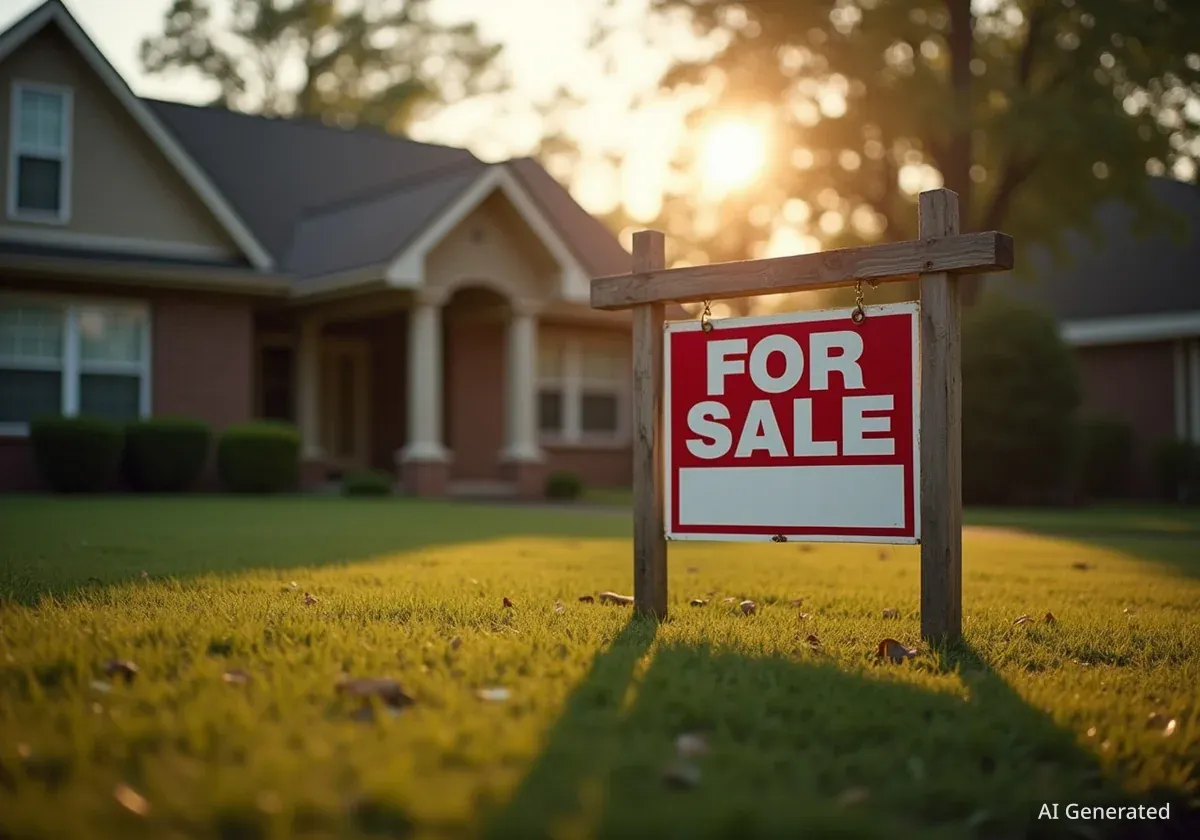Alabama's housing market is experiencing a shift. After a period of rapid growth fueled by low interest rates and high demand during the pandemic, home values across the state have begun to stabilize. Data indicates a slight decline in prices for most areas from January to September.
This trend mirrors broader patterns observed in the southern and western United States. While home values remain significantly higher than pre-pandemic levels, the recent dip suggests a potential return to a more typical housing market environment.
Key Takeaways
- Alabama home values fell by approximately 0.4% from January to September.
- 73% of counties and 69% of cities experienced price drops.
- Higher interest rates are impacting lower-priced homes more significantly.
- The market is shifting from a strong seller's market to a more neutral one.
Statewide Home Values Experience Modest Drop
The typical single-family home value in Alabama saw a decrease of just under $1,000, or about 0.4%, between January and September. This marks the first time since March 2023, and before that, since 2012, that the state has observed an eight-month drop of this magnitude in typical home values.
Despite this recent decline, home prices are still substantially higher than they were before the COVID-19 pandemic. For instance, the average single-family residence in Alabama is currently valued at around $230,000. In December 2019, this figure stood at just under $164,000, representing a significant long-term increase.
"We're almost getting into a sort of normal market. We haven't had a normal market really in a couple of decades."
Market Snapshot
- Average Interest Rate: 6.35% for a 30-year fixed mortgage in September (up from 2.65% in January 2021).
- Consumer Confidence: University of Michigan's Consumer Sentiment Index in September was just over half of pre-pandemic levels.
- Price Cuts: Approximately 20% of houses in Alabama currently have a price cut, aligning with national averages.
Interest Rates and Consumer Confidence Play a Role
Several factors contribute to the current market adjustments. Higher interest rates are a primary concern for many potential buyers. The average interest rate for a 30-year fixed-rate mortgage in the U.S. reached 6.35% in September. This is a significant jump from the low of 2.65% seen in January 2021.
Consumer confidence also plays a critical role. The University of Michigan’s Consumer Sentiment Index in September indicated that confidence levels were just over half of what they were before the pandemic. This uncertainty can lead more people to hesitate when making large financial decisions like purchasing a home.
Historical Context
The Alabama housing market, like the rest of the country, has experienced extreme fluctuations over the past two decades. This includes significant price spikes in the early 2000s, the housing market crash of 2008, and the recent surge in values during the COVID-19 pandemic. The current trends may signal a return to more predictable market conditions after years of volatility.
Navigating a Shifting Market: Education is Key
The rapid changes in recent years mean that many individuals involved in real estate, including buyers, sellers, and even some newer agents, are unfamiliar with what a "normal" market looks like. During the peak of the pandemic boom, homes often sold within days, and bidding wars were common.
Today, houses are not selling as quickly, and buyers are less likely to waive inspections or make offers without contingencies. This shift requires sellers to adjust their expectations and buyers to understand the new dynamics. Educating both parties on current market realities is crucial for smooth transactions.
The share of houses with a price cut in Alabama is now around 20%, mirroring the national average. This indicates that sellers who priced their homes based on 2021 or 2022 market conditions are now feeling the need to adjust.
Geographic Variations in Home Value Changes
The decline in home values was widespread across Alabama. From January to September, prices fell in 49 of the state's 67 counties, representing about 73% of all counties. The most significant drops were concentrated in Alabama’s Black Belt region.
- Perry and Sumter counties each saw typical prices decrease by approximately $18,000 within eight months.
- Jefferson County (Birmingham), Madison County (Huntsville), and Mobile County also experienced price reductions. These are the three most populous counties in the state.
However, not all areas saw decreases. Some counties actually gained value:
- Cullman County: Home values increased by about $6,000.
- Cherokee County: Saw increases of at least $5,000.
- Elmore County: Also experienced increases of at least $5,000.
- Lee County: Recorded increases of at least $5,000.
City-Level Trends
At the city level, approximately 69% of cities and towns in Alabama, or 299 out of 436 places with available data, recorded a loss in home value. Interestingly, some of the state's most expensive cities were among those that gained value.
- Mountain Brook, a suburb of Birmingham and already the most expensive city for home purchases in Alabama, saw the largest increase, a steep $24,000.
- Among the top 10 cities with the highest home values, eight experienced price increases through September.
This trend highlights a key aspect of the current market: buyers and sellers of higher-priced homes are often less affected by fluctuating interest rates. Individuals seeking lower-priced homes, such as first-time buyers, are more sensitive to rate changes.
Market Heat Index Shifts to Neutral
Zillow's market heat index, a metric that indicates whether a market favors buyers or sellers, shows many Alabama markets are cooler than they have been in years. In major markets like Birmingham and Huntsville, this index was in the mid-50s in September.
This figure has been steadily declining, moving these regions into a "neutral market" after several years of being strong seller's markets. Despite the current dip in home values, experts suggest that potential buyers should not be deterred.
"Nothing is certain. Rates going down is not certain. The one thing that tends to be certain is that home prices tend to go up a little bit. The longer you wait, the more expensive that house is going to be. We don't have a lot of inventory. That supply and demand economics lesson is never going to change."
Long-term data supports the idea that home prices generally appreciate over time. With current inventory levels remaining relatively low, the fundamental principles of supply and demand continue to influence the market, suggesting that waiting too long could mean higher prices in the future.





